#they discover smt nocturne
Explore tagged Tumblr posts
Text
Apparently this device called ‘Nintendo Switch’ is simply for amusement of the people…
Nothing like a demon summoning program to be found…..
Many of these ‘games’ however, placed on cards inserted into the device; one can play these ‘games’.
I have found one such titled ‘shin megami tensei: nocturne’ to be most interesting, as the protagonist can fuse demons much like our samurai ~~ however accomplish this in a different way than them… it appears he himself hath turned into a fiend
I do continually hope that this does not turn any who play these ‘games’ into demons…
A relic merely for amusement and amusement alone so it would seem….
Would I get into trouble with the monastery should this relic go missing? It has piqued my interest and curiosity further…. Might I take it away for further research….
There is also one where you pilot a sprite through hoards of orbs being lobbed all across the screen…. Intriguing music but the gameplay however does provoke quite the anxious feeling ~~~ as if facing off against a hoard of demons alone~~
~~ sleeping patterns henceforth get backwards due to ‘research’ ~~
~~ hopes in earnest that no one thinks they’ve caught ill with them sleeping all day and not being around. But surely the sleepiness when they have to be awake during daylight hours is noticeable and might make people think that perhaps ~~
#thoughts#thinking#i think too much#larp#larping#The Eastern Kingdom of Mikado#Mikado#accidental smt iv oc?#someone at the monastery discovers video games and decides to do further research#taking it for further research and messes up their sleeping schedule#hopes to (censored) that they do not get into trouble for the relic gone missing#relic#relics#research#would smt games even be games in universe? that’d be neat#they discover smt nocturne#and bullet hell games#specifically mushihimesama#I hope that this comes off as someone from mikado kind of posting on my account and it’s not actually me#that was my intention with this initially#I suppose I could be helping them tag the posts#idk#silly fun#Nintendo#nintendo switch#shin megami tensei#nocturne#mushihimesama#mushihimesama futari#guess they have anxiety as well?
0 notes
Text
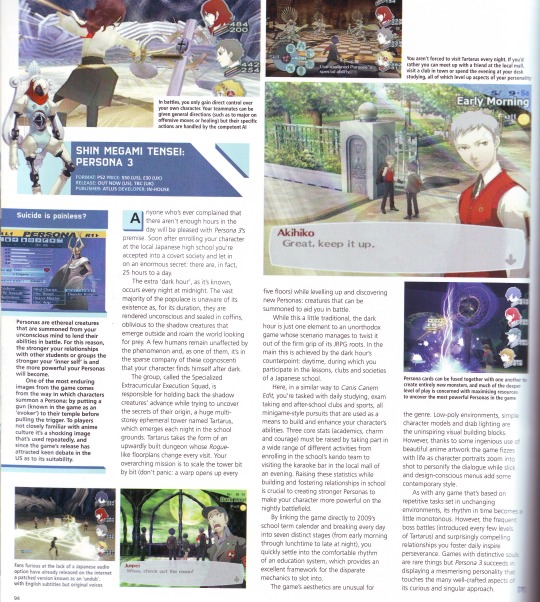
UK Edge Magazine Issue 181 - November 2007 Shin Megami Tensei: Persona 3 (vanilla) in Reviews
this article is actually reviewing the american version rather than the european one - only because persona 3 vanilla hadn't yet come out in europe ! the eu recieved vanilla on february 29th, 2008, half a year after america. often forgotten is that persona 3 was europe's first persona game (but not first SMT, beaten by nocturne in 2005), having missed revelations and eternal punishment entirely. the review compares the gameplay of p3 to canis canem edit (bully, for all you ntscheads), and implies the reviewer opted for the kendo team in their playthrough ^_^
Transcription under the cut:
Shin Megami Tensei: Persona 3 Format: PS2 Price: $50 (US), £30 (UK) Release: Out Now (US), TBC (UK) Publisher: ATLUS Developer: In-House
Suicide is painless?
Anyone who's ever complained that there aren't enough hours in the day will be pleased with Persona 3's premise. Soon after enrolling your character at the local Japanese high school you're accepted into a covert society and let in on an enormous secret: there are, in fact, 25 hours to a day. The extra 'dark hour', as it's known, occurs every night at midnight. The vast majority of the populace is unaware of its existence as, for its duration, they are rendered unconscious and sealed in coffins, oblivious to the shadow creatures that emerge outside and roam the world looking for prey. A few humans remain unaffected by the phenomenon and, as one of them, it's in the sparse company of these cognoscenti that your character finds himself after dark.
The group, called the Specialized Extracurricular Execution Squad, is responsible for holding back the shadow creatures' advance while trying to uncover the secrets of their origin, a huge multi-storey ephemeral tower named Tartarus, which emerges each night in the school grounds. Tartarus takes the form of an upwardly built dungeon whose Rogue-like floorplans change every visit. Your overarching mission is to scale the tower bit by bit (don't panic: a warp opens up every five floors) while leveling up and discovering new Personas: creatures that can be summoned to aid you in battle.
While this is a little traditional, the dark hour is just one element to an unorthodox game whose scenario manages to twist it out of the firm grasp of its JRPG roots. In the main this is achieved by the dark hour's counterpoint: daytime, during which you participate in the lessons, clubs and societies of a Japanese school. Here, in a similar way to Canis Canem Edit, you're tasked with daily studying, exam taking and after-school clubs and sports, all minigame-style pursuits that are used as a means to build and enhance your character's abilities. Three core stats (academics, charm and courage) must be raised by taking part in a wide range of different activities from enrolling in the school's kendo team to visiting the karaoke bar in the local mall of an evening. Raising these statistics while building and fostering relationships in school is crucial to creating stronger Personas to make your character more powerful on the nightly battlefield. By linking the game directly to 2009's school term calendar and breaking every day into seven distinct stages (from early morning through lunchtime to late at night), you quickly settle into the comfortable rhythm of a education system, which provides an excellent framework for the disparate mechanics to slot into.
The game's aesthetics are unusual for the genre. Low-poly environments, simple character models and drab lighting are the uninspiring visual building blocks. However, thanks to some ingenious use of beautiful anime artwork the game fizzes with life as character portraits zoom into shot to personify the dialogue while slick and design-conscious menus add some contemporary style.
As with any game that's based on repetitive tasks set in unchanging environments, its rhythm in time becomes a little monotonous. However, the frequent boss battles (introduced every few levels of Tartarus) and surprisingly compelling relationships you foster daily inspire perseverance. Games with distinctive souls are rare things but Persona 3 succeeds in displaying a mesmerising personality that touches the many well-crafted aspects of its curious and singular approach.
Captions, left to right:
Personas are ethereal creatures that are summoned from your unconscious mind to lend their abilities in battle. For this reason, the stronger your relationships with other students or groups the stronger your 'inner self' is and the more powerful your Personas will become. One of the most enduring images from the game comes from the way in which characters summon a Persona: by putting a gun (known in the game as an 'evoker') to their temple before pulling the trigger. To players not closely familiar with anime culture it's a shocking image that's used repeatedly, and since the game's release has attracted keen debate in the US as to its suitability.
Fans furious at the lack of a Japanese audio option have already released on the internet a patched version known as an 'undub', with English subtitles but original voices.
In battles, you only gain direct control over your own character. Your teammates can be given general directions (such as to major on offensive moves or healing) but their specific actions are handled by the competent AI.
You aren't forced to visit Tartarus every night. If you'd rather you can meet up with a friend at the local mall, visit a club in town or spend the evening at your desk studying, all of which level up aspects of your personality.
Persona cards can be fused together with one another to create entirely new monsters, and much of the deeper level of play is concerned with maximising resources to uncover the most powerful Personas in the game.
#persona 3#edge magazine#i should probably have a tag for the info i uncover like this ehehe .. !#i havent seen scans of this magazine anywhere before :p and also i think pal video game history is so overlooked#sorry it's a bit wonky ! it's an odd size ^_^
14 notes
·
View notes
Text
I've been having this epiphany lately on how the endings to SMT V... actually do make sense.
The problem is that the game is focusing on something that's been implied in past games, that the Law vs Chaos dynamic isn't about ideology. Not after Nocturne had angels fighting for the social Darwinism that usually Chaos champions. The God of Law is only the top dog because he embodied Lucifer's “might makes right” ideal, and when he got to the top he used his power to maintain his rule. That's what Law and Chaos is, the ruling authority and any opposition to that authority.
When Lucifer killed the God of Law, he should have become the Law himself and in a way he did considering the condition of Da'at. But at that point, he discovered that what he did was all part of the Mandala cycle which, in turn, is his ideal of “might makes right” social Darwinism. So he doesn't fully take over the position of top god, but he's stuck in that higher realm at the same time. So he begins a plan to free himself but getting someone to kill him and assume the mantle of top god themselves.
It's not like death sticks for demons. As long as there's some knowledge about Lucifer, some longing to topple oppression, he will return just like YHVH says he will return when he's killed so long as someone believes in him. And there's the possibility that the God of Law is coming back, as something took Tao's soul when she died to create Panagia Tao to direct the Nahobino into taking the throne. It fits his MO with how he changed gods into demons when he took power and took their knowledge away. Hell, Lucifer is shown to be able to do something similar with how he replaced the Demi-fiend's human heart with a demon one in the True Demon route.
If the Nahobino kills Lucifer and takes the throne, he frees Lucifer.
In the Law ending, he opts to uphold God's will. Despite being the new top god, he's upholding the will of one that is supposed to be dead. This causes humanity to lose some of it's freedom, but it also allows Lucifer to try again in the future to break the cycle. The God of Law doesn't even need to retake the Throne to have his will be followed.
Meanwhile, if the protagonist instead opts for the Chaos ending it leads to him restoring power to the various pantheons, who then rule over their people which in turn leads to holy wars when their beliefs don't align. Lucifer is still free, and the God of Law can possibility return due to people praying for an end to the chaos. The Throne is still there for him to challenge the Nahobino.
Those are the endings where the cycle is intact. The neutral ending is to destroy the throne. This fucks over everyone. Lucifer is unfought and stuck in that higher realm, the God of Law can't reclaim his old spot, humans are stuck fighting demons and the miracle that saved humanity is fading away. People say this is more Chaos than anything, but that makes sense as Lucifer is still in a position where he could become top god and therefore make the world chaotic and the cycle that could remove him from power is broken.
The neutral ending implies that the world needs some form of God, just like how the start of the game makes modern Tokyo out to be the result of the God of Law's influence... though that could just be the God of Law trying to gain people to pray to him in order to return.
But the neutral ending can evolve into a better one by completing side quests. People get mad that it seems hypocritical, that after working with demons you expel them from the world to make a world for humanity only. But look how it works: Some demons eat humans, and others absorb humans that hold their Knowledge. From what we see in the Law and Chaos endings is that they want humans to bow down to them, while one of the requirements for the secret ending is defeating Shiva. Shiva, who was getting ready to destroy the world.
You break the Cycle in the secret route while giving Lucifer and God the finger.
The Throne is still there, but god and demons are no longer able to access it as they've been banned from the world. You have fucked over both God and Lucifer's plans, the latter of which doesn't hold back like he does in the other routes where he is the final boss. Humanity is safe from their influence. But at the same time, the player is left alone. As the top god, they can't interact with the world they've created and there's no demons or gods around to accompany them.
The game opens with a recap of original sin, which caused man to be banished from the garden of Eden after listening to Lucifer in snake form. In this ending, after listening to the snake Nuwa to unlock the secret ending, Nuwa who genuinely cares for humanity, you create a world free of the Mandala cycle only to banish yourself, not mankind, from the metaphorical paradise. But even then, there's the uncertainty over whether the cycle can really be abolished or if it will someday return.
And considering this game is basically a sequel to the True Demon Ending of Nocturne, where Lucifer's plan wiped out multiple worlds in order to create a super-demon to fight for him and kill the concept of time... yeah, it feels good to screw that bastard over.
3 notes
·
View notes
Text
really long ask lmao
hello! I’m a newcomer to the shin megami tensei series, introduced through smtv at the start of this year (actually finished nocturne just last week along with starting soul hackers and iv lmao). i discovered your tumblr about a month ago and finally mustered the courage to submit something.
(apologies in advance for having a bunch of questions and if you’ve covered the answers to these elsewhere @_@)
1. what is some folklore/mythology you would personally like to see represented in the series, as a demon or otherwise?
2. not limited to smt, what is some of your favorite kaneko artwork overall?
3. what is your opinion on the success of persona compared to rest of the megaten series?
4. how would you describe your experiences with the megaten community in general?
5. last question what would you say your favorite demons are design wise? personally, among the designs i’ve seen, some that stick out a lot are dominion, chernobog, jersey devil, mother harlot and baal.
____________________________
Hello! 👋 Congratulations on taking that first step and welcome aboard! Sounds like you’ve been busy chipping away at what’s available! I’d be happy to answer your questions.
1. Hmm. This is one of those good common questions I have answered many times but at this juncture, knowing how new SMT games add a couple dozen random demons each time, I would go for my tried and true picks from the Goetia. Buer is one such low-hanging piece of fruit.
2. I’m still overwhelmingly interested in Kaneko’s SMT work. My favorites are the pieces “Advancing Army” and “Advent” illustrated for the covers of Kaneko Works I and II respectively:


3. There’s a very obvious difference in appeal. It is what it is.
4. Well… I’ve been around long enough that I’ve had pretty much every experience possible, good and bad. But I have to say that my ask inbox has been overstuffed for years at this point and I would consider that part of a healthy relationship!
5. Nice choices, esp. Jersey Devil! Honestly I wonder if people would be able to guess my top 5 or so demons at this point? Maybe. There’s always some flux but they would have to be Soul Hackers Odin, Zaou Gongen, Adam, Eve, and probably… Baldur.

And a final word: since you seem to be reading my blog, don’t let my (many) criticisms of the series let you down too much. They’ve really only come about after massive amounts of time with the series and having experienced practically everything it has to offer.
Naturally, when you’re in such a position you want to see NEW things and I think SMT is more than capable of delivering them. Most criticisms come from this perspective and how it is not in my opinion living up to that potential, instead recycling past ideas and broad genre tropes. It bums me out and I’d guess you’d say I’m fairly outspoken, lol.
Thanks for submitting and enjoy SMT!
13 notes
·
View notes
Photo


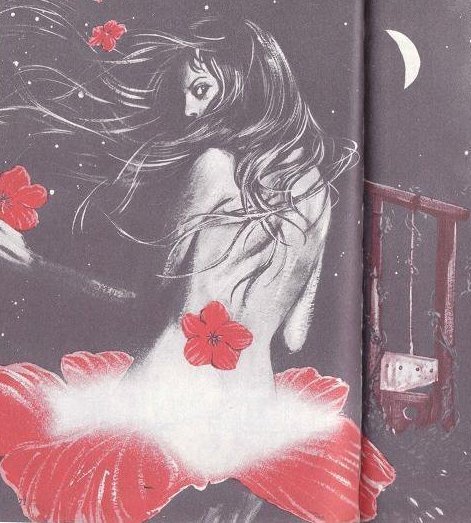
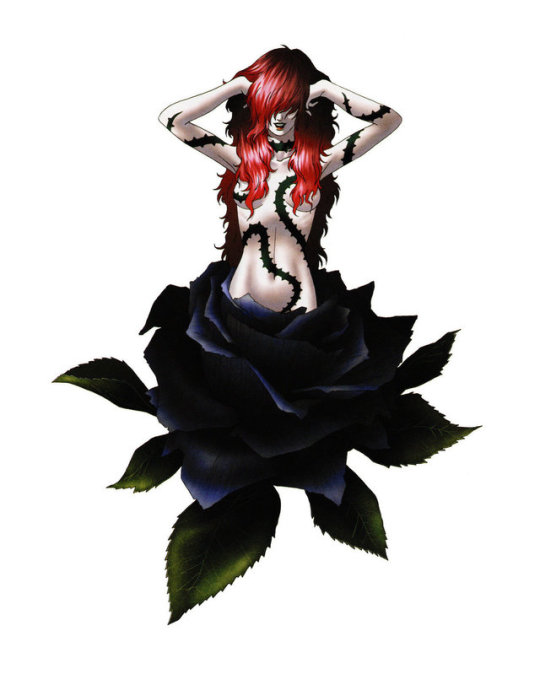


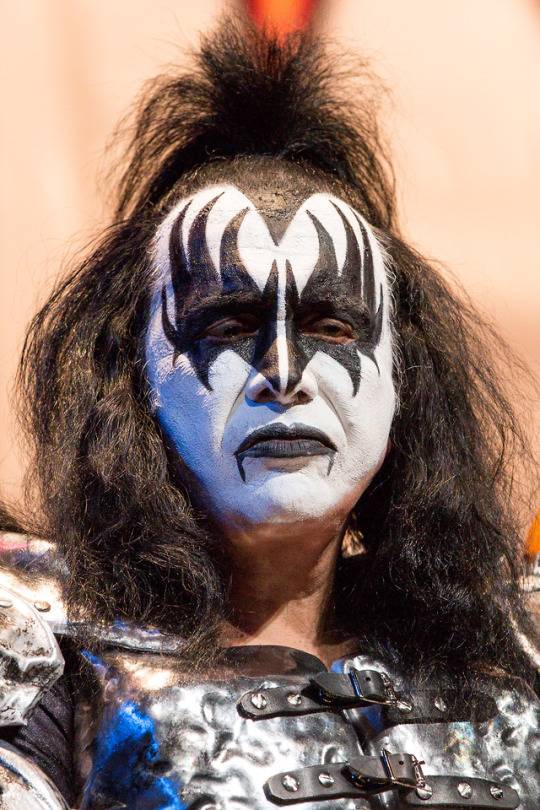
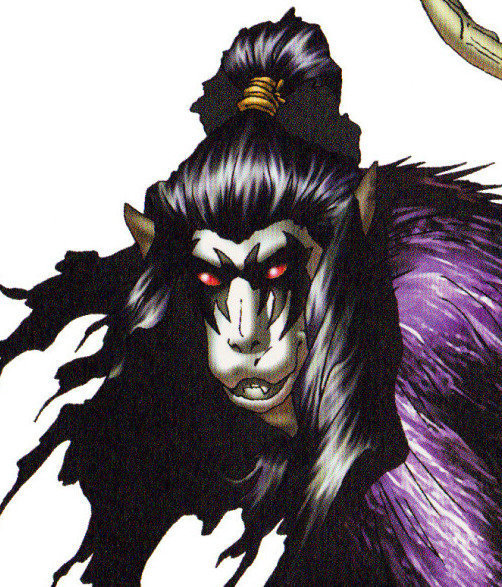


KANEKO'S CRIB NOTES LX: KISS FROM A NIGHT ROSE
That dark and unsettling time of year is once again upon us. With a flash of lightning and a peal of thunder, Kaneko's Crib Notes once again rises from its grave! Kaneko himself, though: still dead. Blame the moe boom.
Anyway, you'll be SHOCKED to the marrow as you discover what we have in store for you this season. Five CHILLING selections so brazen, so unexpected that you'll wish this blog was active more than once a year. So before more CLICHES of TERROR give you the cold sweats, do have a good and HAPPY HALLOWEEN this year. We mean it.
LILITH: From the 1990 film Night Angel. Submitted by @cryomancer199x. SMT1's Lilith is a composite of various elements of Night Angel's Lilith: three fingers, stripes of scaly skin (makeup in the movie's context), rings and jewelry, long, dark hair, and of course the classic snake. For more, check this gallery.
ALRAUNE: From the 1973 Japanese book World Yokai Picture Book. We don't know of an earlier appearance of Japan's now-ubiquitous "naked girl emerging from a large flower" Alraune interpretation, so it's likely this illustration influenced SMT's, Castlevania's, and the slew of horny mobile games to follow.
JUEYUAN: From Gene Simmons' "The Demon" Kiss character makeup. Kaneko gave this Chinese monkey and kidnapper of women a counterfeit of Simmons' iconic makeup. Jueyuan also has a penis-shaped tail, so it's likely an intentional pairing with the frontman's licentious escapades.
APSU: The arms are from a type of clay Astarte (less likely Asherah) figurine. Submitted by @doctorchevlong. Why the Mesopotamian fresh water deity has Canaanite Astarte arms, we couldn't tell you. Just don't let it ruin your day.
MAGATAMA: From Alien Metallinome of Captain Ultra. Submitted by anonymous. The Magatama's open configuration looks a lot like this thing’s head. Rest assured, we here at KCN care deeply about tokusatsu matters.
We’re now up to 120+ unique cribs! Thank you for reading this. Garbage.
#kaneko's crib notes#kazuma kaneko#shin megami tensei#smt#megaten#atlus#lilith#alraune#apsu#jueyuan#magatama#night angel#astarte#kiss#gene simmons#captain ultra#halloween#garbage
235 notes
·
View notes
Text
Lethal vst demonoid

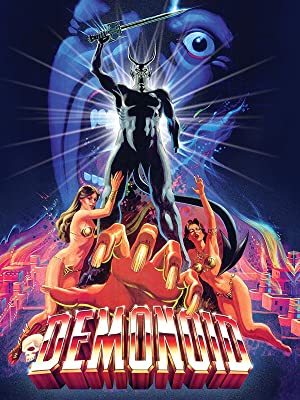
The game uses a blend of old and new MegaTen, with field exploration in 3D, a la Nocturne, but battles in first person 2D with animated sprites, a la Strange Journey. a secret that reveals this is but the beginning of your adventure. With the most senior Samurai refusing to break their code, it's up to you and and your fellow Samurai apprentices to lead the exploration and discover the secret kept hidden at the lowest level of Naraku. Convinced that the answers lie within Naraku (and hungering for the "ancient relics" buried within), the Monastery order the Samurai to travel to the deepest and most forbidden levels of Naraku in search of the "Black Samurai". That is until the Monastery- a religious order of researchers and the most influential faction within Mikado- step in. Yet when a mysterious Samurai in black armour begins to spread demonic influence beyond the borders of Naraku, the Samurai are at a loss. You are chosen to become a Samurai, and learn a truth kept hidden from the general population: that beneath Mikado lies Naraku, a realm of demons which the Samurai are tasked with suppressing.
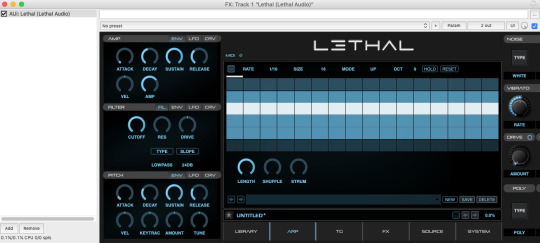
Normally, it is impossible to transcend the class you were born into that is, unless you are chosen at the age of eighteen by "the Gauntlet Rite" to become a Samurai, one of the sworn protectors of Mikado.

The Eastern Kingdom of Mikado is a peaceful land whose inhabitants are rigidly divided into two castes: the common Casualry and the elite Luxurors. SMT IV also marks the first Numbered Sequel in the main series since the release of Shin Megami Tensei III: Nocturne in 2003. Shin Megami Tensei IV is a 2013 game in the main Shin Megami Tensei series, developed by Atlus for the Nintendo 3DS.

0 notes
Note
Is it true that the Star Wars theme was discovered inthe files for SMT: Nocturne?
It’s very common to use scratch tracks while developing games, and sometimes those tracks get overlooked in the code of the game when it ships. I really wouldn’t be surprised if it was used for something.
remember, this is a game where the demi-fiend model was one of this first to be created, so it was used for placeholder animations while other models were in the works, leading to things like this:
so the star wars theme in the game really isn’t surprising
6 notes
·
View notes
Text
Interview with Translator Tom
Today, I spent some time digging into the mind of one of the neglected heroes of the jrpg community. I asked good guy Translator Tom some questions for your reading pleasure. I personally stumbled upon him via his youtube channel where I saw his videos showing off some obscure megaten games.
Translator Tom is responsible for a laundry list of games that are all great in their own way, here’s a list of the megaten ones: Last Bible 2 (2014), Megami Tensei Gaiden: Last Bible Special (2017), Digital Devil Monogatari: Megami Tensei (2018), Last Bible III (2018). For the sake of the interview I refer to myself as my handle, Larrue.
Larrue: How did you get into the translation game?
Translator Tom: It's been so long (about twenty years) that I can't even remember the full situation, how I encountered any translation groups, or anything! I can't even remember the first game I attempted to translate! I suppose it was as soon as I discovered emulation. I'd started learning Japanese around that time. Back in those days, I didn't know half as much as I did now, but I learned as I went, paging through paper dictionaries.
Larrue: Wow that's still impressive! Do you remember how you found megaten?
Translator Tom: Like most people these days, I found out about it through Persona. The first Megaten spin-off I played was Revelations: Persona on the PS1. I loved it, even though pretty much nobody knew anything about it at the time. I learned about the Snow Queen Quest, and after beating it, I ended up going to Japan and buying the Japanese version. I imported IS, EP, SMT 1, 2, if.... I remember buying the Famicom version of Megami Tensei on ebay for $20 and being so relieved nobody else bid on it. I was devastated that nobody knew about the series. I think the first one I attempted to translate was Last Bible II, but that project fell through until much later.
At one point, Gemini and I were even toying with the idea of a Persona 1 PS1 retranslation, at some point after we did Innocent Sin. I still sort of want to do that, even with the PSP release. But active PS1 hackers aren't exactly a dime a dozen.
My favorite Megaten game is Megami Tensei II on the Famicom. DDSTranslation already sort of finished that up with a different translator on the Super Famicom, but I love the aesthetics and sound of the Famicom, so that's another one that's on my wish list.
Larrue: What is one thing you'd want all fans who use the translation patches to know?
Translator Tom: Some translators get really protective about "their" work, but I don't believe I have any claim over the patches. They don't belong to me. All of the translations I've worked on were (of course) done unofficially, so they don't really belong to anyone, and people can use them as they see fit. If people want to sell repros, they can go right ahead. I don't mind.
Larrue: Do you have a dream translation project?
Translator Tom: My dream translation project right now is to translate all of the PC Engine Tengai Makyou games and add them all to the PSP Tengai Makyou Collection. That would be a MASSIVE undertaking, though. When it comes to Megaten, I'd love to do Last Bible 1 for the Game Gear and finish off the series completely. I'm also a huge Devil Children fan, and I want to translate Black, Red, and White Books for the Gameboy Color. (They blow all of the GBA entries out of the water.) (Earlier, I mentioned Megami Tensei II for the Famicom as well.) I doubt working in the game industry would be as fun as working as a fan translator. In the industry, I imagine you have your hands tied a bit, be it by deadlines or company standards and policies. Censorship and stylistic differences would be hard to deal with, too. I'd have to turn a blind eye to that, and it's possible I wouldn't enjoy it as much.
Case in point: My Dragon Quest Monsters Caravan Heart translation. That was done years ago, when I would play the Japanese game, translate the script, and then never play the English version. I used to leave the English version entirely in the hands of the hackers and their editors. I just passed over a rough translation of the script and then washed my hands of it. I later found out that one of the editors suggested changing the menus to the modern Dragon Quest translation conventions (which I can't stand). The patch was released in that state, and I was incredibly frustrated when I eventually found out. It is one of my biggest regrets as a fan translator, and from that point on, I always made sure to play through the English version of the rom before a release.
Larrue: Would you want to do this work for any company in the industry?
Translator Tom: Which company would I want to work for? I can't imagine working for any of them. Maybe Spike Chunsoft? They said they want to become a leader in visual novels in the west. If I was translating anything professionally, I think visual novels would be the most entertaining, and the best opportunity for me to grow as a writer.
Larrue: Last few questions for you: do you have a favorite demon and favorite protagonist?
Translator Tom: My favorite demon is probably Horus as seen in Shin Megami Tensei III: Nocturne. That golden gleam made him seem really unique! Megaten usually has silent protagonists, which I'm not really a fan of, but there a few that talk. That puts them ahead of the pack, in my opinion. I liked Masaki from SMT Devil Children: White Book and Naoki from Majin Tensei II Spiral Nemesis the best. If I had to pick a favorite, I guess I'd go with Naoki, because he's older, so I can relate to him more.
Be sure to follow Tom on twitter here: https://twitter.com/RetroTranslator
Watch his youtube uploads here: https://www.youtube.com/channel/UC9Q6I1inXxSd6sSgXcOBOyA
18 notes
·
View notes
Text
Playing shin megami tensei 3 nocturne HD remake, game is super cool. The smt series always impresses me with its well paced story telling and this one seems especially fast paced. The magatama system is pretty neat, but I do miss the equipment system from 4, makes treasure chests kinda boring when you already know the best shit in there is a healing item. I also definitely miss the way smt 4 would tell you what the enemy's weakness was once you discovered it when you hovered your cursor over the enemy, very convenient for someone who sometimes can't play for a few days at a time because of real life and has adhd memory problems. Very excited to keep playing though
0 notes
Text
Futurest Games
Good Morning Gamers!

Every woman needs a good chick flick to stir up a few tears now and then. Having played two examples of what can be created in Far Cry Arcade at a preview event, there's huge potential in the mode, and not just for endless variations on shooting challenges. One, Upside Down, strips out all weapons and simply far cry 5 pc download charges the player with escaping from a nightmarish three-dimensional maze. With corridors constructed out of ominous grandfather clocks and rooms unsettlingly populated by deer and other wildlife you might encounter in the main game, there's no active threat, but ominous music and the time pressure make the mind-warping experience particularly tense.
Fable is an action role-playing series that is available on Xbox, Xbox 360, Windows and Mac. The game series currently has three games released in 2004, 2008 and 2010. Find far cry 5 pc download details on over 30 of the most-anticipated games headed to the Xbox One in 2018.
Far Cry 5 is an action-adventure first-person shooter video game developed by Ubisoft Montreal and Ubisoft Toronto and published by Ubisoft for Microsoft Windows , PlayStation 4 far cry 5 pc download and Xbox One It is the successor to the 2014 video game Far Cry 4 , and the fifth main installment in the Far Cry series. The game was released on March 27, 2018.
Thanks to an early review copy from Ubisoft, I have spent a whole lot of time in Far Cry 5's Hope County to this point, and I'm now in a position to share some of my knowledge far cry 5 pc download with you all who are just starting out after the game's release yesterday.
I agree with like 60 percent of your lists the other parts are basically i didnt play or i didnt enjoy far cry 5 pc download as much as i thought i would, but have you played any of persona or games like smt nocturne? those games are pretty cool.

The game also features a recruitment system in which the player can recruit locals in the county to fight alongside them similar to the "Buddy" system used in Far Cry 2 or the "Guns for Hire" system in Far Cry 4. In this Guns for Hire system, the player can recruit locals to join their cause at which point they will fight alongside the player. In addition to these Guns for Hire, the game also includes "Specialists" or non-playable characters with their own unique skills far cry 5 pc download and personalities. The recruitment system replaces the beacon system used in previous titles. For example, Far Cry 3 featured radio towers and Far Cry 4 featured bell towers that the player had to climb in order to open up parts of the map and various activities in the region. Far Cry 5 removed this system and instead rely on the player forging relationships with other characters to discover story missions, events and other characters.
Is there a solemn usher who always wears a suit to church? Put him in a long wig and a rock band outfit. Let your children's pastor portray a spoiled, bratty kid. Your most talented vocalist play an American Idol contestant that sings way off key. By using familiar people far cry 5 pc download in your church with known traits and talents and putting them into a role that is the complete opposite of who they are in real life, you create instant humor for any skit.
0 notes
Note
How is it that the central aspect of the MT franchise is so overlooked compared to Pokemon or Digimon, seemingly both within the fandom and internally at Atlus?
I was talking about this with @joshquixote a bit, who mentioned this relevant quote from Pokemon creator Satoshi Tajiri from November 1999:
http://content.time.com/time/magazine/article/0,9171,2040095,00.html
Tajiri: It’s interesting, because in Japan, everybody goes for Pikachu. In the U.S., the characters Ash [Satoshi in Japan] and Pikachu are grouped together. American kids seem to like that. In America there are more products sold with Ash and Pikachu together, not just Pikachu alone. I think Americans actually understand the concept of Pokemon better than the Japanese. The Japanese focus on Pikachu, but what I think is important is the human aspect–you need Ash.
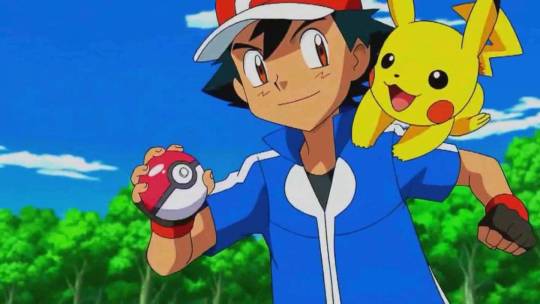
Basically, because Pokemon was initially just a monster collecting/trading game in Japan, Pikachu was perceived as being an individual PKMN; in the US, we got absolutely blitzed by a marketing bonanza for the series’ launch that heavily included Ash (particularly the anime), so the two were seen as inseparable. You know, in 1999. It’s probably different now, almost 20 years later.
There’s undoubtedly a split in perception between the US and Japan for Shin Megami Tensei’s demons, too. Here are some random thoughts about the topic (including those from a discussion with @sorenblr):
Japanese fans are naturally privy to every MT/SMT novel, game, book, anime, interview, etc. ever released while the English-speaking world has access to a fraction, much of that fraction from fan translations. The average JP SMT fan just has a better understanding of the series’ context and content than their non-JP counterparts. (If you are reading this blog, chances are that you aren’t a casual SMT fan, so this might not apply to you.)
SMT features more Japanese demons than those from any other single region. It doesn’t mean the average Japanese person will know every single one, but they might still claim affinity with them in ways a Western player won’t. Ame no Uzume, Tenaga, and Waira are not household names here. A fair number know Amaterasu, but as a wolf.
Related to that, Japan’s religious systems of Shinto and Buddhism ensure that the average person there will be more familiar with polytheism than our monotheistic culture, including comparisons to Hindu deities imported to Japan through Buddhism; in the West we are most familiar with polytheism through Greek and Norse myths and only the Norse are well-repped in SMT (moreover, the famous names are generally high-level, which many players may never access). A good 75% (honestly, just a number I’m throwing out there) of any given SMT compendium has little significance to the average Western player.
Building off that, monotheism and Euro folklore figure in plenty (25% is still 100+ demons in recent games) and will probably be the most-recognized overall by Western SMT players. Angels, Fallen demons, Jack Frost, fairies, and Alice come to mind for this category.
In a personal example that intersects of all the elements discussed so far, I read so many passionate defenses of Amemiya’s angel designs in SMT4, but I can’t remember a single one about the similarly bizarre looks for SMT4′s Japanese demons like Michizane, Koga Saburo, or Yamato Takeru. The interest or awareness for JP demons just isn’t correspondent among the English-speaking fanbase.
The lack of regularly introduced demons doesn’t help; the lack of new faces may cause the average player’s eyes to gloss over the old. Seeing Patrimpas for the third or fourth time isn’t going to ingratiate him further (or at all) in the hearts of players.
Some demons have become memes, for better or worse. Awareness of YHVH is high, as antagonistic depictions of him are rare; sometimes SMT is called the series “where you kill the Christian God,” which is amusing to me. Then there’s Mara, of whom only a small minority of non-JP SMT players seem to know his actual significance. And like Mara, some demons are able to coast by merely from their appearances alone, esp. “cuties” like Alice, Moh Shuvuu, Jacks, and Decarabia.
Other demons are remembered if they have exceptional utility. Daisoujou is popular in Nocturne not because he’s a mummified monk but for having essentially unlimited healing at a relatively low level, as are the other Fiends for their exceptional resistances. There’s probably disappointment when the same demon isn’t broken from game to game.
Demon mechanics probably don’t agree with a lot of people, either, lending them the effect of negative conditioning. Complaints about demon negotiation and even fusion are common. Even though fusion is easier with manual skill selection, demons still require a level of micromanagement that may be too much for some. Demons are also meant to be expendable in ways that say, Pokemon, aren’t.
Speaking of things that are expendable, expectations of what “monsters” are from other RPG series likely affect attitudes towards SMT’s demons. Plenty of RPG series use names of mythological beings for its disposable mobs, to the point that it’s unusual when they don’t. Worse, SMT doesn’t do a great job of informing people that there may be something more to its demons. Even as a “monster collecting” series, SMT probably come out too late in the US after the likes of Pokemon, Digimon, or Monster Rancher to have much impact with its traditional formula.
Demons/personas will also forever be overshadowed by human characters. This is to be expected as they are the focus of the narrative. People like me who really don’t give a damn about the humans are squarely in the minority.
Finally, and this is likely isn’t as relevant now, but there’s how Atlus USA initially marketed Nocturne. It didn’t get anything near a Pokemon Red/Blue campaign, but it did get this fascinating print ad. Here’s a snippet:
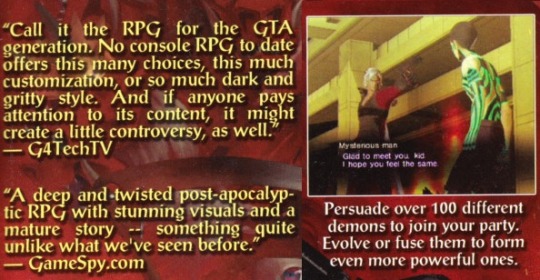
“The RPG for the GTA generation.” “Dark and gritty.” “Controversy.” “Mature.” “Post-apocalyptic.” I mean, it’s all accurate, and then there’s the “over 100 different demons” as a caption for an image of Dante, the Geralt of 2004. Dark, mature armageddon + lots of demons to collect. But really, I’m not implying they made any mistakes here; these are the limits of marketing. Calling it “Religions Battle 200X” and describing it as “a granular exercise in the representation of myth” doesn’t make for enticing ad copy.
This answer was difficult to write; ultimately, the exact reasons why the demons are overlooked are entirely subjective, but I think the common patterns have been identified here. Against all odds, the value of myth in SMT is something the individual player needs to discover for themselves. Look no further than my own example, as when I first played Nocturne in 2004 pre-myth I found it boring, then a year later post-myth it transformed into one of my most engaging game experiences ever.
I think SMT’s biggest fault re:demons is that it doesn’t provide them enough in-game context for the Western audience; they’re plopped into a modern setting and they want to kill you, or they look like Sarutahiko and they want to bland you to death. To get the most out of it, SMT basically requires you have outside knowledge of myth and religion, which is a lot to ask for a general audience. Unfortunately, I don’t see demon awareness improving anytime soon.
61 notes
·
View notes
Link
"...We used the Japanese-Jewish Common Ancestor Theory as the base." -Yusuke Miyata, Shin Megami Tensei IV: Apocalypse scenario writer (source) "If we were to follow the theory that the [Japanese] Imperial Family is part of the Hebrew lineage, then [Masakado] would also become the one who opposed the Jews. The imperfect hero, so to speak. It would be cool if that kind of man existed." -Kazuma Kaneko, series artist and creative director (source) Japanese-Jewish common ancestry theory is the most important idea in Shin Megami Tensei you've never heard of. Its nature is self-evident, proposing that the Japanese are secretly descended from an ancient tribe of Israel. It sounds crazy, but it's no theory that its ideas have received some serious endorsements from Atlus staff, from a series scenario writer all the way up to top dog Kazuma Kaneko himself.
This article promises to be the most in-depth investigation possible of Shin Megami Tensei's usage of Japanese-Jewish common ancestry theory--including a dark side of anti-Semitism, as alleged by the title. But even as the series shoots itself in the foot with its handling of certain matters, SMT's application of Japanese-Jewish common ancestry theory is surprisingly broad and deserving of the diverse range of discussion topics contained within, including:
The history of the theory and its main arguments, as pertaining to SMT
Elucidating the series' portrayal of YHVH
The supernatural force that actually powers demon summoning in the series
The significance of Nocturne's Baal Avatar
Why certain Japanese demons are Jewish
Explanations of some of Kaneko's weirder comments
Why Raidou Kuzunoha actually serves YHVH
And of course, a full analysis of the anti-Semitic themes that emerge from misuse of the theory
This is a huge subject, the revelations of which have huge ramifications for Shin Megami Tensei and Atlus. It is unlikely you will view SMT the same way again after discovering how the theory permeates myriad aspects of the series both anticipated and unanticipated. To know Japanese-Jewish common ancestry theory is to understand Shin Megami Tensei's inner workings!
After months of research, I present this gargantuan look at Japanese-Jewish common ancestry theory and Shin Megami Tensei! I think that’s all that needs to be said!
READ MORE!

#shin megami tensei#japanese jewish common ancestry theory#japan#judaism#masakado#smt2#smt4#smt4a#megaten#atlus#kazuma kaneko#anti-semitism
139 notes
·
View notes